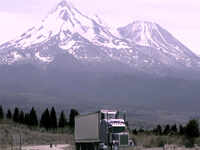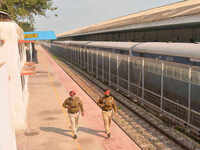Study finds 200,000 Californians face volcano risk
Nearly 200,000 people live, work or pass through California's volcanic hazard zones on a daily basis. That according to a new report broadly assessing what could be at risk from an eruption. The impacts of an eruption, estimated to have a probability of 16 percent in the next 30 years, would likely extend well beyond local areas due to effects on utilities, telecommunications, water and transportation systems. The study was conducted by the U.S. Geological Survey in cooperation with the California Governor's Office of Emergency Services. The research spotlights a natural hazard that receives less attention than wildfires, earthquakes, floods and landslides that happen more frequently. The most recent of at least ten eruptions in the past 1,000 years occurred at Northern California's Lassen Peak from 1914 to 1917. Lassen is one of eight volcanic areas up and down the state that are designated as having moderate, high or very high threat. The group includes California's most iconic volcano, snow-capped Mount Shasta, which towers over the landscape south of the Oregon border, and the less-recognizable Long Valley volcanic region on the eastern side of what is now Yosemite National Park. They have the two largest populations of volcanic areas, about 100 thousand around Mount Shasta and more than 60 thousand around the four volcanoes in the Long Valley region. Thousands of tourists also visit the parks surrounding the volcanoes every year and hundreds of passenger jets fly over California volcanoes daily. But the report should not be taken as a "doomsday scenario." Instead researchers said it's a call for citizens and agencies to understand volcano hazards and to prepare for them.
- whatsapp
- Facebook
- twitter
- GOOGLE+
- Email
- linkedin
- Embed
- messgae
MORE VIDEOS
 01:00Study finds 200,000 Californians face volcano risk
01:00Study finds 200,000 Californians face volcano risk 00:30Samjhauta Express resumes, days after service was suspended
00:30Samjhauta Express resumes, days after service was suspended 01:24Use common sense, PM Modi tells Opposition
01:24Use common sense, PM Modi tells Opposition 01:52Money-laundering case: ED grills Chanda Kochhar
01:52Money-laundering case: ED grills Chanda Kochhar 00:35Scientist offers to donate Rs 110 cr for Pulwama martyrs
00:35Scientist offers to donate Rs 110 cr for Pulwama martyrs 04:17We hit the target during strike on terror camps in Pak: BS Dhanoa
04:17We hit the target during strike on terror camps in Pak: BS Dhanoa 01:04Mahashivratri 2019: Devotees offer prayers at Lord Shiva temples across the country
01:04Mahashivratri 2019: Devotees offer prayers at Lord Shiva temples across the country 01:31Was Balakot air strike an election gimmick, questions Navjot Singh Sidhu
01:31Was Balakot air strike an election gimmick, questions Navjot Singh Sidhu 02:25Woman from Srinagar bats for gender equality through fitness training
02:25Woman from Srinagar bats for gender equality through fitness training 01:23Kumaraswamy clarifies his remarks on air strike
01:23Kumaraswamy clarifies his remarks on air strike 01:20Siddaramaiah lashes out at Narendra Modi, says PM’s ‘insensitivity can’t be washed away by dipping in any river’
01:20Siddaramaiah lashes out at Narendra Modi, says PM’s ‘insensitivity can’t be washed away by dipping in any river’ 01:51Congress president Rahul Gandhi accuses PM Narendra Modi of misleading public
01:51Congress president Rahul Gandhi accuses PM Narendra Modi of misleading public
 01:00
01:00 00:30
00:30 01:24
01:24 01:52
01:52 00:35
00:35 04:17
04:17 01:04
01:04 01:31
01:31 02:25
02:25 01:23
01:23 01:20
01:20 01:51
01:51